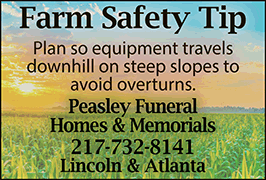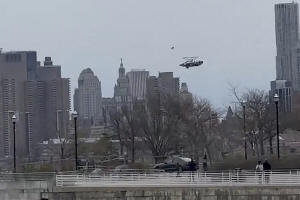Deadly crash raises new questions about safety of New York’s helicopter
tours
[April 12, 2025]
By PHILIP MARCELO
NEW YORK (AP) — A helicopter ride giving a thrilling sweep of
Manhattan’s iconic skyline has long been on the to-do list for New York
City tourists of means.
For several hundred dollars, tour companies fly passengers high above
the rivers that encircle the city, showcasing a stunning, bird's-eye
view of the Statue of Liberty, One World Trade Center and other
monumental landmarks.
But Thursday’s crash that killed a family of five visiting from Spain
and the helicopter’s pilot, a Navy SEAL veteran, has renewed concerns
about the safety of the popular sightseeing excursions.
Since 2005, five helicopters on commercial sightseeing flights have
fallen into the Hudson and East rivers as a result of mechanical
failures, pilot errors or collisions, killing 20 people.
Longtime opponents have revived calls to ban or limit “nonessential”
helicopter flights, including the roughly 30,000 sightseeing rides over
the city each year.
Mayor against more restrictions
Mayor Eric Adams on Friday said he doesn’t support further restrictions
on the aircraft, saying they’re crucial for everything from transporting
Wall Street executives to police work, and that tens of thousands of
tourist flights happen each year with no problems.
“People want to see the city from the sky,” he said on WINS radio,
though he added that "it must be done right.”
The Democrat said the city's airspace is highly regulated, pilots are
well-trained and the aircraft are well maintained.

Not everyone has his level of comfort.
“Personally, I don’t go on them,” Al Yurman, a former investigator with
the National Transportation Safety Board, said of helicopter tours. “I
feel like the industry doesn’t look after itself the way it should.”
Previous crashes led to new rules
Tourist flights seemed like they might be in jeopardy after a disaster
in 2009, when a Liberty Helicopters sightseeing flight carrying Italian
visitors collided with a private plane over the Hudson River, killing
nine.
After that crash, which involved missed radio communications, a
distracted air traffic controller and two pilots who didn't see each
other until it was too late, the Federal Aviation Administration created
new safety rules for the congested airspace over the city's rivers.
A few years later, New York City cut the number of flights allowed at
Manhattan’s downtown heliport in half, capping them at just under 30,000
a year.
Then, in 2018, five people died when a helicopter offering “open door”
flights crashed in the East River after a passenger's restraint tether
snagged on a fuel switch, stopping the engine. The pilot escaped but the
passengers couldn't get out of their safety harnesses and drowned.
That crash prompted more industry scrutiny.
Late last month, the company that arranged that flight, FlyNYON, settled
a lawsuit over the crash for $90 million. FlyNYON's chief executive,
Patrick Day, said it had made numerous changes to improve safety,
including changing its passenger restraint system, switching to a
different model of helicopter, adding training for pilots and hiring a
safety officer.

[to top of second column]
|

In this photo taken from video, a helicopter falls from the sky into
the Hudson River , Thursday, April 10, 2025, in Jersey City, N.J.
(Bruce Wall via AP)

“The introspection and self-critical analysis we have undertaken in
the last six-and-a-half years have shaped our view of what it means
to be an industry leader, and we’re a safer, smarter, and stronger
company for it,” Day said.
Fewest crashes in 25 years
The cause of Thursday’s crash is still undetermined.
Videos taken by bystanders showed the Bell 206 helicopter breaking
apart mid-flight. The cabin plummeted into the water without its
severed tail boom or main rotor, which spun off into a different
part of the river and hasn't been recovered.
Nationwide, there were 88 helicopter accidents last year across all
sectors — the lowest in 25 years, according to Jeff Smith, chairman
of the Eastern Region Helicopter Council, a trade group for
helicopter operators based in Kearny, New Jersey, where many
Manhattan tour companies depart.
Helicopter tours, he added, accounted for a small fraction of all
those accidents.
“We shoot for vision zero, which means no fatalities,” Smith said.
“We train for that. We preach it. It is a cornerstone of our
industry.”
Justin Green, an aviation lawyer and former Marine helicopter pilot,
agreed there’s nothing especially problematic about New York’s
helicopter tour industry, despite the crashes that seem to happen
every few years.
At the same time, he said, tour operators should be required to
equip their aircraft with modern safety measures, such as terrain
awareness technology.
Steve Cowell, a Colorado-based aviation expert, suggested the FAA
should take a more active role in scrutinizing smaller operators
with known financial difficulties.

“Unfortunately, when people fly, they oftentimes do not check into
the safety records or financial viability of the company,” Cowell
said. “They’re placing their trust and confidence in the abilities
of not only the pilots but the maintainers.”
New York Helicopter, operator of the aircraft that crashed Thursday,
had gone through a bankruptcy and been sued twice by creditors in
recent months, an AP review found.
The company declined to answer questions, but released a statement
saying it was “profoundly saddened" by the deaths of its passengers
and pilot.
“The safety and well-being of our passengers and crew has always
been the cornerstone of our operations,” it said.
All contents © copyright 2025 Associated Press. All rights reserved |